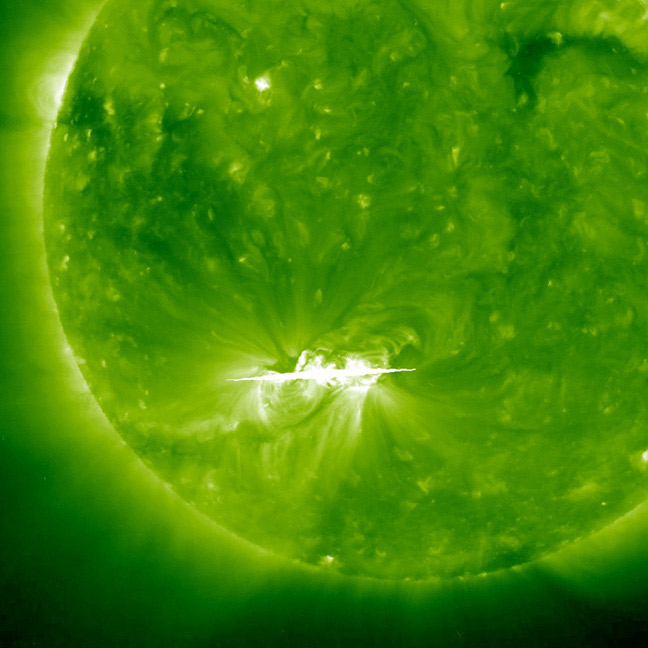Sun Unleashes Most Powerful Solar Flare in Years

A major solar flare erupted from the sun Saturday — one of the most powerful in years — sending an energetic blast of X-rays from a hotspot of activity that may still belch more solar storms in the days to come.
The X-ray blast occurred Nov. 6 at about 11:36 EDT (1536 GMT) from an active group of sunspots called 1121. It was the third major flare from the solar hotspot and registered a Class M 5.4 on the scale for sun storms, according to the Space Weather Prediction Center operated by NOAA. [Photo of Sunspot Group 1121]
"Astronomers who study the sun have five categories of flares: A, B, C, M and X," explained SPACE.com's skywatching columnist Joe Rao. "The M and X flares are the most potent types and the one that erupted [Saturday] was an M 5.4 which is just about the most powerful flare we've seen in many years."
At the time of the flare, sunspot group 1121 was on the limb, or the edge, of the sun's disk, so any cloud of electrified particles ejected by the flare would not reach Earth, Rao said.
"But as the sun rotates, this active region of the sun will be turned more and more toward the center of its disk … it will be there around Nov. 12 to 13," Rao said. "If a similar M-class flare erupts around that time, we could be in line to see a very nice display of northern lights a day or two later when the cloud of electrified solar particles reaches Earth."
According to the website Spaceweather.com, which monitors space weather and sky events, the radiation from the solar flare "created a wave of ionization in Earth's upper atmosphere that altered the propagation of low-frequency radio waves."
Severe solar flare events can cripple satellites and pose a risk to astronauts in orbit, and also have the potential to knock out power grids on Earth. NASA recently began a project, called the Solar Shield, to provide early-warning alerts to electricity providers to help limit damage to power utility infrastructure as a result of extremely powerful solar storms.
Get the Space.com Newsletter
Breaking space news, the latest updates on rocket launches, skywatching events and more!
The sun is currently entering an active period of its 11-year solar weather cycle after a lull in activity.
Join our Space Forums to keep talking space on the latest missions, night sky and more! And if you have a news tip, correction or comment, let us know at: community@space.com.

Tariq is the Editor-in-Chief of Space.com and joined the team in 2001, first as an intern and staff writer, and later as an editor. He covers human spaceflight, exploration and space science, as well as skywatching and entertainment. He became Space.com's Managing Editor in 2009 and Editor-in-Chief in 2019. Before joining Space.com, Tariq was a staff reporter for The Los Angeles Times covering education and city beats in La Habra, Fullerton and Huntington Beach. In October 2022, Tariq received the Harry Kolcum Award for excellence in space reporting from the National Space Club Florida Committee. He is also an Eagle Scout (yes, he has the Space Exploration merit badge) and went to Space Camp four times as a kid and a fifth time as an adult. He has journalism degrees from the University of Southern California and New York University. You can find Tariq at Space.com and as the co-host to the This Week In Space podcast with space historian Rod Pyle on the TWiT network. To see his latest project, you can follow Tariq on Twitter @tariqjmalik.









